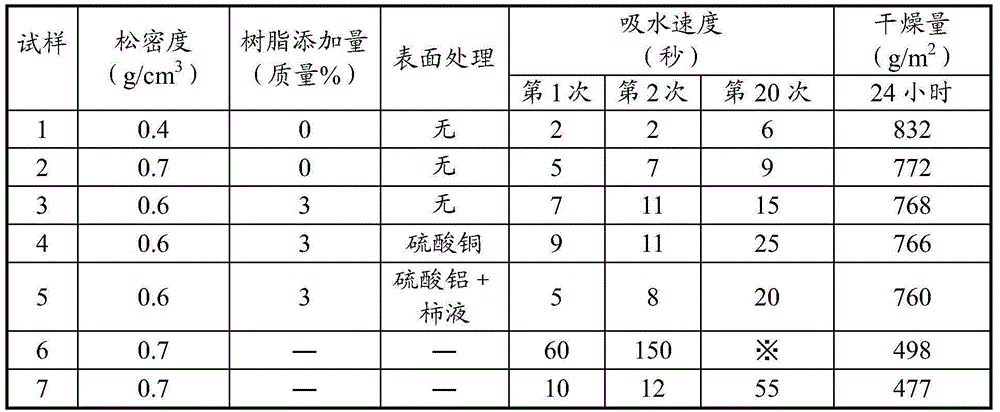Manufacturing method of foot drying pad
A manufacturing method and technology for foot pads, which are applied in the field of manufacturing foot pads, can solve the problems of reduced water absorption speed, leaving a damp feeling, slow drying speed, etc., and achieve the effects of low water absorption speed, inhibiting damp feeling, and high water absorption
- Summary
- Abstract
- Description
- Claims
- Application Information
AI Technical Summary
Problems solved by technology
Method used
Image
Examples
Embodiment 1
[0069] Mix 48 parts by weight of quicklime, 52 parts by weight of silica and 1200 parts by weight of water to prepare raw material slurry. 2 ), stirring the raw material slurry for 4 hours at a temperature of 197° C. and performing a hydrothermal reaction. By this hydrothermal reaction, an aqueous slurry containing secondary particles in which xonotlite and a small amount of tobermorite were mixed was obtained.
[0070] Prepare the above-mentioned water-based slurry of 77 parts by weight in terms of solid content, further, mix 2 parts by weight of bentonite, 16 parts by weight of ordinary Portland cement, 2 parts by weight of waste paper pulp and 3 parts by weight of glass fiber. After the water-based slurry mixed with the above-mentioned various materials is poured into a predetermined amount of mold, it is 2 Dehydration was carried out under pressure, and the obtained dehydrated molded body was dried in the air at 150° C. to obtain an inorganic molded board. A bulk densit...
Embodiment 2
[0072]Prepare the aqueous slurry containing the secondary particles mixed with xonotlite and a small amount of tobermanite obtained in embodiment 1 that is 90 parts by weight in terms of solid content, and further, mix 2 wt. 5 parts by weight of white cement, 5 parts by weight of glass fiber and 3 parts by weight of styrene-acrylate resin. After the water-based slurry mixed with the above-mentioned various materials is poured into a predetermined amount of mold, it is 2 Dehydration was carried out under pressure, and the obtained dehydrated molded body was dried in the atmosphere at 120° C. to obtain an inorganic molded board. A bulk density of 0.6 g / cm was obtained by surface grinding the inorganic formed board. 3 Inorganic forming board. This inorganic form board is sample 3.
Embodiment 3
[0074] The inorganic molded body obtained in the same manner as in Example 2 was cut to a predetermined size. Next, press 100 g / m on one side of the cut inorganic molded body with a brush. 2 After applying a 9% by mass aqueous solution of copper sulfate (industrial copper sulfate was used), drying was performed in the atmosphere at 105° C. for 2 hours. The inorganic shaped body thus obtained (bulk density 0.6 g / cm 3 ) is sample 4.
PUM
| Property | Measurement | Unit |
|---|---|---|
| density | aaaaa | aaaaa |
| density | aaaaa | aaaaa |
| density | aaaaa | aaaaa |
Abstract
Description
Claims
Application Information
 Login to View More
Login to View More - R&D
- Intellectual Property
- Life Sciences
- Materials
- Tech Scout
- Unparalleled Data Quality
- Higher Quality Content
- 60% Fewer Hallucinations
Browse by: Latest US Patents, China's latest patents, Technical Efficacy Thesaurus, Application Domain, Technology Topic, Popular Technical Reports.
© 2025 PatSnap. All rights reserved.Legal|Privacy policy|Modern Slavery Act Transparency Statement|Sitemap|About US| Contact US: help@patsnap.com

